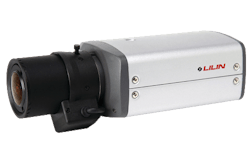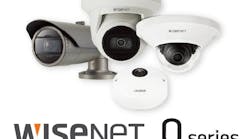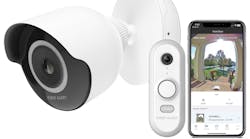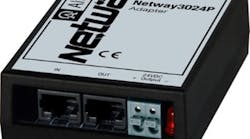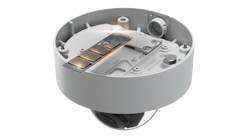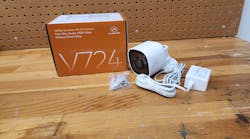Cameras in a video surveillance system often serve as a deterrent to crime, much like a secure deadbolt installed onto the front door of a home or business. A burglar would see the deadbolt lock on the door and decide to burglarize another building that did not have a deadbolt. Likewise, a video surveillance camera mounted onto the exterior of a business or home will likely give a miscreant a moments pause, and s/he hopefully will go elsewhere.
Video surveillance cameras have the following five primary functions:
- Provide visual proof that your business or home is functioning normally and everything is safe.
- Determine who is in the business or home.
- Act as a deterrent against theft and unauthorized access.
- Monitor locations where supervision is needed but personnel are not always available.
- Record an event should one occur. A camera that has sufficient resolution can then be used as evidence to corroborate an action.
Choosing a video surveillance system involves meeting customer needs, wants and resources. Most of the time, the wants and needs must be balanced in order to fit the budget, available storage space and Internet bandwidth.
When choosing video surveillance cameras, it is important to realize there is no one camera model or type that will be the best choice for every application. Cameras come in different configurations.
Some of the more important considerations are resolution (megapixels), lens, indoor or outdoor placement, day & night or daytime operation, vari or fixed focal, zoom, Infrared (IR), Backlight Compensation, alarm function, audio, cabling and operating temperatures. Knowing the application and location is extremely important when choosing the camera.
Cameras come in three basic types: the box camera, the bullet camera and the dome camera. Each camera type provides specific advantages.
A box camera is video surveillance camera that does not have an external enclosure. It is normally attached to a bracket. The image sensor and components are contained with a box. The lens is exposed to the elements. The box camera is designed for indoor applications, and installed where there is sufficient light and the camera is protected.
A dome camera is a video surveillance camera that is mounted into an enclosure having a dome shaped cover through which the camera records. A dome camera can be surface mounted onto the ceiling and walls. Some dome cameras can be embedded (flush mount). Because of the design, dome cameras have tilt rotation, horizon rotation (ceiling mount) and pan rotation, which enables the camera lens to be adjusted in order to record at a specific point.
A style of the dome camera is the turret camera. This type of video camera can have a tilting/revolving turret that contains the camera. Most turret cameras can be adjusted without having to remove a dome. Turret cameras are available as day & night IR cameras.
The bullet camera, which is shaped somewhat like a bullet, is an enclosed type of camera. A sun shield usually covers the lens to protect the camera from direct sunlight. For extreme weather conditions, some bullet cameras have built-in heaters and blowers to maintain the internal temperature of the housing with specific temperature ranges. An average operating temperature range for a bullet camera equipped with a heater and blower is -40° C to +50°C. Many bullet cameras have a weather-resistant ousing.
The important differences between the three camera configurations are indoor or indoor and outdoor applications, day & night versus day only, Infrared (IR) sensitivity and vandal resistance.
Outdoor cameras must be able to continue to exist in the installed climate. A box configuration camera is an indoor camera. Dome and bullet cameras can be used outdoors depending on the weather conditions and the camera design capabilities. Outdoor cameras used in severe climates can be equipped with heaters, windshield wipers, etc. Weatherproof enclosures on exposed applications are a must-have, regardless of the climate. Weatherproof enclosures and heaters are available on some dome and bullet camera configurations. A heater requires additional power approximately 10 watts at 24VAC.
A video camera used for 24 hour surveillance must have sufficient light to produce the images. During the day or indoors, ambient light is sufficient for most surveillance cameras. However, if the light quality is poor or during night, a camera "can see in the dark," provided there is sufficient infrared light illuminating the area. To do this, the day & night camera changes the imagery from color to black & white. Infrared light is beyond the human visible range, but most surveillance camera sensors can detect and use it to produce black and white images.
Several methods are used to provide images in low light environments that restrict the use of artificial light. One method is to equip the surveillance camera with IR LEDs. When the light decreases to where color images cannot be produced, the LEDs illuminate and the camera switches from producing color images to black & white images. The size and number of Infrared LEDs surrounding the camera lens determine the distance and the spread of the IR. The illumination produced enables black & white images to be seen.
Another method incorporates an Infrared Cut Filter that can be automatically or manually scheduled to switch from Day (color) to Night (monochromatic). During the day, the IR-Cut Filter filters out the Infrared light so the colors of the images do not distort. At night, with the camera in the black and white mode, the filter is deactivated, enabling the cameras' light sensitivity to operate at the minimum Lux. For some surveillance cameras, this can be 0.1 Lux or lower at a specified F stop.
An option to improve the quality of the imagery for a night camera to improve the quality of the imagery is to use an IR Illuminator that provides white and Infrared illumination for indoors and outdoor applications when the Lux can be zero. The range of an IR Illuminator is from approximately about 30 feet to more than 300 feet, with the illumination angle from 10 degrees to 180 degrees using a single panel at a fixed angle. Power over Ethernet (POE) and Vandal Resistant IR Illuminators are available.
Of the three surveillance camera configurations, the dome camera offers the best form of vandal resistance for several reasons. The cameras are mounted within a dome structure that has a solid base. Bullet and box cameras are normally mounted onto a bracket. The base of the dome cameras are conically shaped to resist attack. Some dome cameras are available with vandal-resistant domes that are constructed from varying thickness of high-impact polycarbonate.
In addition to vandal resistance, some models meet IP66 wind/rain standards. IP (Ingress Protection) ratings are defined in international standard EN 60529. A dome camera with an IP66 rating has a totally dust tight housing providing intrusion protection and moisture protection against string water jets and waves. IP67 contains the standards of IP66 plus the ability to be immersed in up to one meter of water.
Editor’s Note: In the previous two installments of Jerry Levine’s series on video surveillance, we discussed the basics of a video surveillance system. The nest installment will cover camera operation including lens, focal length, adjustments, zoom, var-focal, fixed focus, image sensor, effective pixels, etc.
